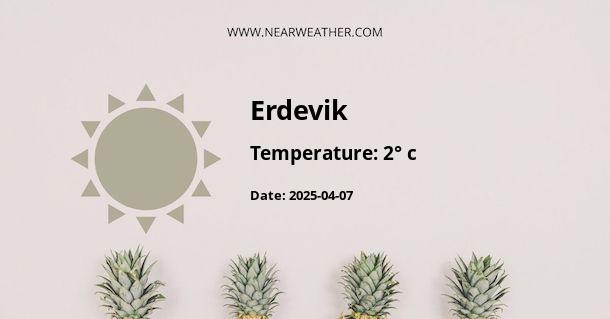Understanding Erdevik's Climatic Conditions: An In-Depth Overview
Erdevik is a charming village located in the autonomous province of Vojvodina within Serbia. Renowned for its serene landscapes and vibrant cultural heritage, Erdevik has a climate that is categorized as continental, marked by cold winters and hot, humid summers. This detailed guide will explore the meteorological intricacies of Erdevik, providing those who intend to visit or learn about the area with valuable climatic insights.
Annual Climate Patterns of Erdevik
Erdevik's climate can be classified within the Köppen climate classification as "Dfb": Warm summer continental or hemiboreal climate. It is characterized by significant weather variations between seasons, influenced by its geographic position in the Pannonian Plain, with its proximity to the Carpathian Mountains and the Danube River.
"The climate of Erdevik is a true representation of the four seasons, offering a diverse range of weather conditions that cater to a variety of outdoor activities throughout the year." - Serbian Meteorological Institute
Winter:
- Temperature: Temperatures during the winter months can dip below freezing, often averaging between -2°C to 3°C (28°F to 37°F).
- Precipitation: Snowfall is frequent, providing a picturesque winter landscape. The average annual snowfall is around 20-30 cm (7.9-11.8 inches).
- Summary: Expect cold, crisp weather, with occasional intense cold spells influenced by the Siberian anticyclone.
Spring:
- Temperature: A gradual increase in temperature starts in March, with average figures spanning from 5°C to 15°C (41°F to 59°F).
- Precipitation: May is considered the wettest month with frequent showers aiding the blooming flora.
- Summary: Spring in Erdevik is a transitional period with a noticeable increase in daylight and a variety of weather patterns.
Summer:
- Temperature: July and August are the hottest months, with temperatures that can exceed 30°C (86°F).
- Precipitation: Occasional thunderstorms and periods of drought are not uncommon during the summer months.
- Summary: Warm and generally humid conditions prevail, perfect for agricultural activities that dominate the region.
Autumn:
- Temperature: A gradual cooling occurs with averages ranging from 10°C to 20°C (50°F to 68°F).
- Precipitation: Autumn rainfall helps to balance out the drier periods of summer and prepare the soil for winter.
- Summary: Autumn often brings about a mix of mild, pleasant days and crisp, cooler nights.
Climate Data Analysis for Erdevik: Examination and Synthesis
With climate data spanning several decades, precise statistical analysis of climate trends for Erdevik is possible. The Serbian Meteorological Institute provides long-term records, which aid in identifying any shifts in climate patterns, potentially consequent upon broader global climate changes.
| Month | Average High (°C) | Average Low (°C) | Precipitation (mm) |
|---|---|---|---|
| January | 2 | -4 | 37 |
| February | 5 | -2 | 35 |
| March | 11 | 1 | 40 |
| Annual | --- | --- | 576 |
Current analysis indicates a slight upward trend in average temperatures, with increasing extremes such as heatwaves and cold spells. It's essential for stakeholders, particularly in agriculture, to incorporate these changing conditions into their long-term planning and practices.
Climate's Impact on Local Life and Economy
The weather and climate in Erdevik have a significant impact on the local lifestyle and economy. Agriculture and viticulture, for instance, are central to the village's economic structure, both of which are dependent on the area's distinctive climate.
"Climate not only influences the yield and quality of crops but also governs the character and traditions of the local community." - Expert in Agricultural Sciences, University of Novi Sad
Signs of climate adaptation are evident through the introduction of irrigation systems to counter the effects of summer droughts and the selective breeding of crop varieties more resilient to climatic stress. Moreover, the burgeoning wine industry in Erdevik—famous for its local grape varietals—owes much of its success to the interplay of terrain, sun exposure, and climatic conditions that are peculiar to the region.
Adapting to Climate Variability in Erdevik
Adaptation strategies are crucial for the region's sustained growth and prosperity. Strategies include:
- Implementing advanced meteorological forecasting and advisory services to inform agricultural planning.
- Reducing carbon footprint by promoting sustainable practices and renewable energy utilization.
- Adjusting crop sowing dates and utilizing heat and drought-tolerant crop varieties.
- Conserving water and improving soil management to maintain productivity during adverse weather conditions.
Future Climate Projections for Erdevik
Climatological research predicts that Erdevik, in line with wider regional trends, will face increased temperatures and variable precipitation patterns in the coming decades. Expert climatologists suggest the below scenarios:
- Rise in temperatures: An overall increase in average temperatures, extending the length of growing seasons but also creating potential for more frequent heatwaves.
- Changes in precipitation: A likely increase in the occurrence of extreme rainfall events, leading to localized flooding, yet interspersed with drier intervals.
- Impact on ecosystems: Native flora and fauna may need to adapt or face increased stress, with potential impact on biodiversity.
Conclusion
In summary, Erdevik's climate is in a state of flux, mirroring broader global trends. Yet with prudent planning and adaptive measures, the community can continue to thrive amid these changes. Further research and consistent climate monitoring remain essential to foster resilient strategies for the long-term welfare of both the local community and the regional environment.
Leveraging detailed climatic data, expertise in continental weather systems, and an understanding of local socio-economic dependencies, stakeholders in Erdevik are well-equipped to navigate the complex tapestry of challenges and opportunities presented by their unique climate.
A - Erdevik's Latitude is 45.116940 & Longitude is 19.407499.
A - Weather in Erdevik is 10° today.
A - Climate Conditions in Erdevik shows clear sky today.
A - Humidity in Erdevik is 79% today.
A - Wind speed in Erdevik is 8.28 km/h, flowing at 283° wind direction. today.
